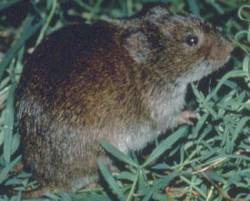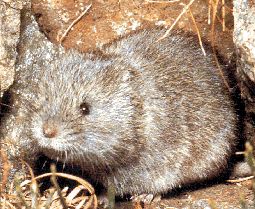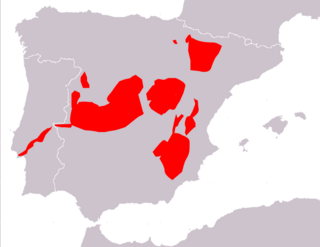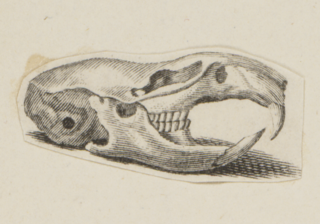
The Arvicolinae are a subfamily of rodents that includes the voles, lemmings, and muskrats. They are most closely related to the other subfamilies in the Cricetidae. Some authorities place the subfamily Arvicolinae in the family Muridae along with all other members of the superfamily Muroidea. Some refer to the subfamily as the Microtinae or rank the taxon as a full family, the Arvicolidae.

The eastern meadow vole, sometimes called the field mouse or meadow mouse, is a North American vole found in eastern Canada and the United States. Its range extends farther south along the Atlantic coast.

Microtus is a genus of voles found in North America, Europe and northern Asia. The genus name refers to the small ears of these animals. About 62 species are placed in the genus. They are stout rodents with short ears, legs and tails. They eat green vegetation such as grasses and sedges in summer, and grains, seeds, root and bark at other times. The genus is also called "meadow voles".

The northern red-backed vole is a small slender vole found in Alaska, northern Canada, Scandinavia and northern Russia.

The singing vole, is a medium-sized vole found in northwestern North America, including Alaska and northwestern Canada.

The eastern heather vole,, is a small North American vole. Until recently, this species was considered to belong to the same species as the western heather vole, Phenacomys intermedius. It is also called the Ungava vole.

The Mexican funnel-eared bat is a bat species found in Central America and the Caribbean.

The California vole is a type of vole which lives throughout much of California and part of southwestern Oregon. It is also known as the "California meadow mouse", a misnomer as this species is a vole, not a mouse. It averages 172 mm (6.8 in) in length although this length varies greatly between subspecies.

The European snow vole or snow vole is a species of rodent in the family Cricetidae. It has dense, pale grey fur and a pale-coloured tail and can reach about 14 cm (5.5 in) long, with a tail which is 7 cm long.

Brandt's vole,, also known as the steppe vole, is a species of rodent in the family Cricetidae. It is native to shrublands and grasslands in Russia, Mongolia and northern China.

Cabrera's vole is a species of vole native to Spain and Portugal. It is named for Ángel Cabrera, a mammalogist then working at the Museo Nacional de Ciencias Naturales in Madrid. It is the only living member of the subgenus Iberomys, although two fossil species are also known, including M. brecciensis, the likely direct ancestor of the living species.

The narrow-headed vole is a species of rodent in the family Cricetidae. Ranging over northern and central Asia and also into Alaska, it is the only species in the subgenus Stenocranius.
The Guatemalan vole is a species of rodent in the family Cricetidae. It is found in Guatemala and Chiapas, Mexico, in montane pine-oak forest and meadow at elevations between 2600 and 3100 m above sea level. It is terrestrial and probably diurnal or crepuscular.
Schelkovnikov's pine vole is a species of rodent in the family Cricetidae. It is found in Azerbaijan and Iran. It has recently been considered the sole species in the subgenus Hyrcanicola.
The Zempoaltépec vole is a species of rodent in the family Cricetidae. The name Microtus is from the Greek word mikros meaning small and otus meaning ear. The name umbrosus could be from the Latin umbros meaning shady. It is rather large and has a long tail when compared with other voles. Its pelage is long and soft. In the upper parts, the hair is uniformly dusky with brown tips and the lower parts a dark grey thinly washed with a reddish yellow color. It is found only in Mexico, in a semi-isolated mountain range southeast of the Cajones River in Mixes district, in Oaxaca.
The Colombian rice rat, also known as the white-footed Handley's mouse is a species of rodent in the family Cricetidae occurring only in Colombia. It was previously included in Oryzomys, but closely resembles the dusky montane rat, and accordingly both species were placed in the new genus Handleyomys in 2002.
The nimble-footed mouse is a species of rodent in the family Cricetidae. It is found only in Mexico.

The Taiwan vole is a species of rodent in the family Cricetidae, It is an endemic species of Taiwan. This species is herbivorous with a preference for the Yushan cane.

The large-toothed shrew or Mexican large-toothed shrew is one of 77 species within the genus Sorex. Registered on the IUCN Red List as vulnerable with a decreasing population, the Mexican large-toothed shrew has been recorded only 14 times in seven locations. The shrew is a member of the red-toothed shrew subfamily Soricinae, and the more taxonomically defined tribe Soricini. Members of the latter category exhibit long tails relative to body size.

Arvicolini is a tribe of voles in the subfamily Arvicolinae.















